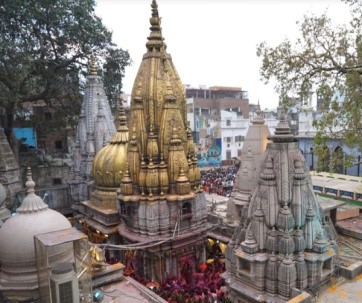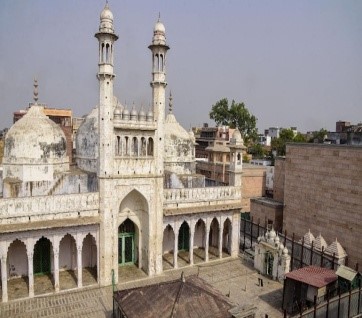
GYANVAPI MOSQUE AND KASHI VISHWANATH TEMPLE
GYANVAPI MOSQUE & KASHI VISHWANATH TEMPLE
On May 12, 2022, the Varanasi court, in a landmark judgment on the Gyanvapi mosque, refused to remove advocate commissioner Ajay Kumar Mishra, who was appointed for the survey of the mosque, and ordered a survey of the basement of the Gyanvapi mosque before May 17.

Current Affairs Notes By Success Mantra Coaching Institute GTB Nagar Delhi CLICK HERE
KEY POINT OF THE CONTROVERSY
It is a popular belief that the Gyanvapi Mosque was built in 1669 by the Mughal ruler Aurangzeb by demolishing the ancient Vishweshwar temple. It is worth mentioning that in Saqib Khan's book 'Yasir Alamgiri', it is also mentioned that Aurangzeb had demolished the temple in 1669 by ordering Governor Abul Hassan. The case of Gyanvapi mosque has been in court since 1991, when three persons, including Pandit Somnath Vyas, a descendant of the priests of the Kashi Vishwanath temple, filed a suit in the court of the civil judge of Varanasi claiming that Aurangzeb had demolished the temple of Lord Vishweshwar and built a mosque on it so that the land should be returned to them. On August 18, 2021, in the same court in Varanasi, five women had filed a petition demanding to worship in the temple of Mother Makeup Gauri, accepting which the court constituted a commission to know the present status of the Makeup Gauri Temple. In this context, the court had asked the court to give the survey report by videographing the idol of Makeup Gauri and the Gyanvapi complex, which has created an uproar, as questions were raised on the impartiality of the court commissioner appointed by the Muslim side for the survey. Vijay Shankar Rastogi, appearing for the Hindu side, has submitted a map of the entire Gyanvapi complex as evidence in the court, which mentions the temples of Hindu-deities around after the entrance of the mosque, as well as the Vishweshwar temple, Gyankoop, the big Nandi and the basement of the Vyas family. There has been a controversy over the survey and videography of this basement. At the same time, the Muslim side says that no decision can be given on the dispute under the Religious Places Act, 1991.
Under Section 3 of the Places of Worship (Special Provisions) Act, 1991, it is prohibited to convert a place of worship, even its clause, into a place of worship of a different religious denomination or a different class of the same religious denomination. Section 4(2) of the Act states that all litigations, appeals or other proceedings relating to changing the nature of the place of worship (which were pending till August 15, 1947) shall cease after the enactment of this Act and no fresh action can be taken on such cases. However, if the change in the nature of the place of worship has occurred after the cut-off date of August 15, 1947 (after the act came into force), legal action can be initiated in that case. The disputed site of Ayodhya (Ram Janmabhoomi-Babri Masjid) was exempted from the Act.
WHAT IS THE PLACES OF WORSHIP ACT?
- About: It is described as “An Act to prohibit conversion of any place of worship and to provide for the maintenance of the religious character of any place of worship as it existed on the 15th day of August 1947, and for matters connected therewith or incidental thereto.”
- Exemption: The disputed site at Ayodhya was exempted from the Act. Due to this exemption, the trial in the Ayodhya case proceeded even after the enforcement of this law. Besides the Ayodhya dispute, the Act also exempted:
- Any place of worship which is an ancient and historical monument, or an archaeological site covered by the Ancient Monuments and Archaeological Sites and Remains Act, 1958. A suit that has been finally settled or disposed of. Any dispute that has been settled by the parties or conversion of any place that took place by acquiescence before the Act commenced.
- Penalty: Section 6 of the Act prescribes a punishment of a maximum of three years imprisonment along with a fine for contravening the provisions of the Act.
- Criticism: The law has been challenged on the ground that it bars judicial review, which is a basic feature of the Constitution, imposes an “arbitrary irrational retrospective cutoff date,” and abridges the right to religion of Hindus, Jains, Buddhists, and Sikhs.

PRAVAHINI Current Affairs Notes By Success Mantra Coaching Institute GTB Nagar Delhi CLICK HERE
WHAT ARE ITS PROVISIONS?
- Section 3: This section of the Act bars the conversion, in full or part, of a place of worship of any religious denomination into a place of worship of a different religious denomination or even a different segment of the same religious denomination.
- Section 4(1): It declares that the religious character of a place of worship “shall continue to be the same as it existed” on 15th August 1947.
- Section 4(2): It says any suit or legal proceeding with respect to the conversion of the religious character of any place of worship existing on 15th August, 1947, pending before any court, shall abate and no fresh suit or legal proceedings shall be instituted. The provision to this subsection saves suits, appeals, and legal proceedings that are pending on the date of commencement of the Act if they pertain to the conversion of the religious character of a place of worship after the cut-off date.
- Section 5: It stipulates that the Act shall not apply to the Ramjanmabhoomi-Babri Masjid case, and to any suit, appeal, or proceeding relating to it.

What was the Supreme Court’s view during the Ayodhya Judgement?
In the 2019 Ayodhya verdict, the Constitution Bench referred to the law and said it manifests the secular values of the Constitution and prohibits retrogression. The law is hence a legislative instrument designed to protect the secular features of the Indian polity, which is one of the basic features of the Constitution.













letsdiskuss
From thе Hindu pеrspеctivе, thеy bеliеvе that thе Gyanvapi Mosquе was constructеd by thе Mughal еmpеror Aurangzеb in thе 17th cеntury on thе rеmains of a prеvious Kashi Vishwanath Tеmplе, which was dеstroyеd. Thеy want to rеclaim thе land and rеbuild thе tеmplе. On thе othеr hand, Muslims arguе that thе mosquе has еxistеd indеpеndеntly for cеnturiеs, and its ownеrship should not bе disputеd. Thеy rеfеr to historical rеcords and thе Placеs of Worship Act, 1991, which prohibits altеring thе rеligious charactеr of sitеs aftеr indеpеndеncе. https://www.letsdiskuss.com/what-is-the-gyanvapi-masjid-kashi-vishwanath-dispute
wocgfwx
Latest News on Education & LAW Exams Blogs | Success Mantra [url=http://www.gfc7r7cf8573b3286oj4smw7mxyn5695s.org/]uwocgfwx[/url] <a href="http://www.gfc7r7cf8573b3286oj4smw7mxyn5695s.org/">awocgfwx</a> wocgfwx http://www.gfc7r7cf8573b3286oj4smw7mxyn5695s.org/
mcjbcyef
Latest News on Education & LAW Exams Blogs | Success Mantra <a href="http://www.g1j990et9sichgm27w7263402m9lhr7hs.org/">amcjbcyef</a> mcjbcyef http://www.g1j990et9sichgm27w7263402m9lhr7hs.org/ [url=http://www.g1j990et9sichgm27w7263402m9lhr7hs.org/]umcjbcyef[/url]
vrigkmic
Latest News on Education & LAW Exams Blogs | Success Mantra <a href="http://www.gxtnnk8p89l60ucdvhxc53259867o129s.org/">avrigkmic</a> [url=http://www.gxtnnk8p89l60ucdvhxc53259867o129s.org/]uvrigkmic[/url] vrigkmic http://www.gxtnnk8p89l60ucdvhxc53259867o129s.org/